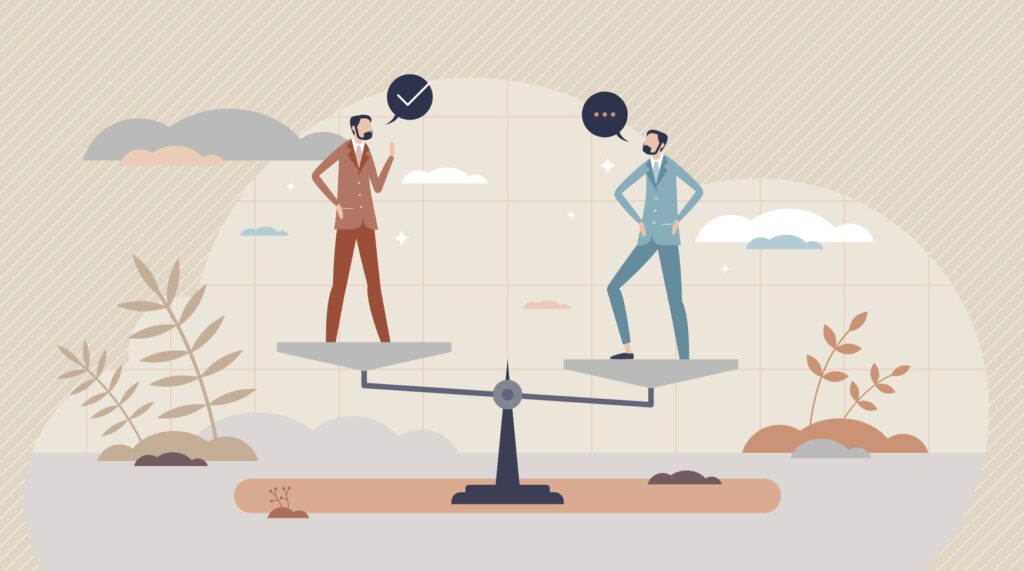“Chance is commonly viewed as a self-correcting process in which a deviation in one direction induces deviation in the opposite direction to restore the equilibrium. In fact, deviations are not ‘corrected’ as a chance process unfolds, they are merely diluted.”
Amos Tversky, Judgment Under Uncertainty: Heuristics and Biases
Epistemology, the knowledge of knowledge—the root of all Enlightenment inquiry—asks the question: what do we know? (Que sais-je, in Montaigne’s words.) The best way to understand a problem is to start from a position of humility and investigate empirically what we know step by step. Remove all assumptions and what are we left with? A place to start without bias.
How do professionals think? It is commonly believed that people with advanced college degrees, such as doctors and lawyers, operate on a sophisticated level due to the benefit of education and training. The reality, however, is that professionals largely work by heuristics, that is, rules of thumb garnered after years of practice from which the professional generates self-imposed guidelines, which may result in bias and prejudice. This is especially true when the professional believes that the case is “old hat” or when the client is seen as a part of a particular group, thus excluding the possibility of understanding specific circumstances or alternate theories in a case.
This article suggests that checking bias and eliminating assumptions is the key to better professional conduct. Moreover, it is equally crucial to disabuse opposing counsel of bias and prejudice through both professional acumen and extra-legal support.
Bias and Prejudice in the Court
Bias and prejudice is a major issue in criminal law where there is considerable bias and prejudice against a criminal defendant’s skin color, age, ethnicity, gender, or simply because of what kind of clothes the defendant is wearing. For example, when a client (or lawyer) walks into court with a $2,000 Giorgio Armani suit, there is an immediate assumption about the defendant’s financial status and perhaps professional accomplishments. Nalini Ambady’s early work illustrates that our understanding of others is at least partly determined by snap visual judgments based on unconscious non-verbal cues called “thin slices,” including facial expression and body language, which also inform our perceptions of racial and cultural stereotypes.
I must confess that when I see a defendant in prison garb I have a strong tendency to assume wrong-doing even if the defendant is only being detained before trial, which should allow for a presumption of innocence. In fact, a presumption of guilt is actually more reasonable than a presumption of innocence. We generally assume (I hope) that police act in a legitimate manner and that prosecutors also act within the confines of the law (I hope) without holding on to exculpatory evidence. If we generally believe that the police and prosecutors act in good faith in the large majority of cases then it is reasonable to believe that the large majority of defendants indeed committed the wrong they are accused of. As such, the presumption of guilt is more reasonable than the presumption of innocence.
A prominent historic example of bias in family court was the “tender years doctrine” which basically asserted the presumption that children should live with their mother because it was assumed that mothers provide better parental support than fathers, especially when children are young. Another huge presumption that developed seemingly out of thin air was the idea that in marital separation a wife (spouse) was entitled to half of the assets from her professional husband, such as a lawyer or doctor, because she contributed half to her husband’s professional success. This excludes the possibility that the professional husband may have fared far better professionally if he did not marry or that the husband was traumatized given the pressure to provide a high income to his wife, which may even have harmed his health or reduced his longevity. Additionally, if the wife is so important to the husband’s financial gains in his professional career would not the separation show a sharp decline in his success, professionally and financially?
In civil and criminal litigation, the facts should be on trial not the defendant as such. There is a very real difference. As far as I’m concerned in criminal cases (and perhaps civil cases as well) the defendant should have the right to sit behind a one-way mirror if we really want to avoid bias and prejudice. Physical presence leads to bias because of skin color, gender, body language, and even clothing. In contrast, professionals and the legal system can combat bias through facts—fairly understood in their broadest possible light.
As far as I’m concerned in criminal cases (and perhaps civil cases as well) the defendant should have the right to sit behind a one-way mirror if we really want to avoid bias and prejudice.
Theories of Error
Among the most important thinkers of our time is Daniel Kahneman, a Nobel laureate in economics who never actually took an economics course. His research (along with Amos Tversky) reveals that judgment and decision-making is often based on biases, prejudices, and false assumptions that ultimately prohibit the professional from acting in a manner consistent with the best practices of the profession.
Kahneman reshaped the psychology of human judgment by proposing that instead of dependency on complex systems, we in fact only use a limited number of simple cognitive short hands, or heuristics, when presented with limited outside information. While it may be easier to make good judgments if all pertinent information is available, many of the decisions we make in every-day life are made without such advantages. When faced with a knowledge-poor situation or under constraints of time or uncertainty, we instead depend on rules of thumb or cognitive heuristics.
Heuristics fall into three main types of cognitive errors where biases occur. “Anchoring” occurs when a person overvalues the first data he encounters and subsequent thinking is skewed. “Availability” occurs when recent or dramatic cases quickly come to mind and color judgment about the situation at hand. “Attribution” occurs when stereotypes and prejudices affect thinking so conclusions arise not from data but from preconceptions. (Howard Rheingold noted that attention is a valued limited resource, so that we should pay attention to where you pay attention.)
A major outcome of this phenomenon is that professionals tend to be overconfident about their understanding of problems, which can cause them to overestimate their knowledge, underestimate risks, and exaggerate their ability to control events.
Every criminal lawyer has encountered cases where prosecutors do not consider all available facts, they are overconfident because the case appears routine (“just another drug bust”) or refuse to consider alternate theories or mitigating circumstances.
Research supports that overconfidence and the use of heuristics become more serious problems given a high level of education and a high degree of responsibility that the individual attains. The neophyte prosecutor who completed four years of college, three years of law school, and the state bar exam, now believes he is more than prepared to take on any criminal allegation. The reality, of course, is that such prosecutors are only beginning their careers as attorneys and should recognize their limitations, as a means to minimize error. (Among the most interesting essays in Kahneman’s book concerns radiologists who misread mammograms to rule out breast cancer due to heuristics and biases in judgment, rather than objective judgment. Studies have found equally erroneous behavior in many other areas of medicine. Moreover, in the world of finance, for example, there are two main implications in investor overconfidence: the first is that investors take bad bets because they fail to realize that they are at an informational disadvantage and the second is that they trade more frequently than is prudent, which leads to excessive trading volume. (See, Shefrin, Hersh. Beyond Greed and Fear: Understanding Behavioral Finance and the Psychology of Investing. 2000.))
In Thinking, Fast and Slow (2011), Kahneman asserts that there are two kinds of thinking. “System one” entails quick, automatic, intuitive responses often in dire situations when fight or flight responses are needed while “system two” thinking helps to regulate system one, as it relies on slow deliberative rational thinking and judgment which requires effort, time, and energy. The large majority of our decisions are system one in nature. Kahneman argues that both are required for sound judgment and that system one and two complement one another to the thinker’s benefit. While system one entails a knee-jerk reaction system two is deliberative and reflective—and motivates us toward better understanding.
Decisions are Based on Emotions not Rationality
Decisions are based on emotions not rationality. The rational actor model posited by many political scientists and others, including the prolific Judge Richard Posner, a member of the United States Court of Appeals for the Seventh Circuit and professor of law at the University of Chicago, fundamentally omit that decisions are based on our emotions and what appears as rationality is actually justification or rationalization of our emotional decision- making and judgment.
The reality is that our decisions, proclivities, interests, likes and dislikes—and even biases and prejudices—are ultimately based on a calculus rooted in psychological and emotional underpinnings (such as fear, sadness, anger, resentment, anxiety, and even retaliation), which we then rationalize as reasonable (or even logical) based on a perceived fact pattern and our present and past experiences. This is called post-hoc rationalization. (The majority of our decisions are based on guilt, which is not rational at all.)
While data and facts are important they struggle to confer context or nuanced humanistic meaning, which is available only through personal narrative. For this reason, reading a single biography of a Holocaust survivor may provide greater empathy and insight into the horrors of the Nazi regime as compared to statistical accounts of depleted populations in towns throughout Europe where Jews once thrived.
For this reason, it is extremely important to be self-aware of our emotions—and egos—recognizing whether a professional decision is rooted in sound judgment or judgment rooted in emotions that may be irrational, dangerous, or even self-destructive. For centuries, Jews were forced to leave various European countries, including England, France, Germany, Holland, Hungary, Portugal, and Spain, among others. This was based mostly on religious and racial hatred, however, the reality is that the expulsion of Jews from these countries terribly undermined the economy in those states, and it is said that Spain never truly recovered from the 1492 expulsion of Jews from its territory .
By ego, I mean our sense of self-esteem, self-worth, and even self-concept. This analysis also helps us to anticipate our opponent’s decision-making. When our opponent is sweating, shaking, stutters, or nervous it is because the issue under discussion touches him in a very personal way. The most ruthless negotiators are those who are aware and manage their own emotional issues while never losing sight of essential facts and goals—and one’s opponent’s emotional issues and personal agenda. As such, the most ruthless negotiators are also the most at ease with themselves and others.
Seeing Patterns Where None Exists
Bias and prejudice about the client, issues, and facts are informed by perception and context—and affect. As such, another major problem of overconfidence and the use of heuristics is that the professional tends to see patterns where none exists. The clippitty clop sound you hear is probably a horse but it may be a zebra—such that the intuitive is inherently untrustworthy. The professional may extrapolate various facts in a case and assemble them in an orderly fashion in his own mind in an effort to make meaning out of them. Thus, Scott Peterson may be executed for murder due to circumstantial facts and demeanor evidence that combined together convinced the prosecutor that he was guilty. Nonetheless, it would appear that no direct proof exists.
Sometimes, of course, seemingly disparate facts are not related and simply exist close to one another by sheer coincidence. Coincidence, luck, and misfortune are central elements to human existence that are not considered particularly seriously, and are generally ignored even by economists and financial experts, as noted in Nassim Nicholas Taleb’s The Black Swan: The Impact of the Highly Improbable. (2007). Seeking accuracy as part of life will help us better gauge our professional ability and appreciate that our knowledge must be weighed against our rather limited understanding of the world and our effort to explain it.
Creativity and Imagination
Another problem with overconfidence and heuristics is that professionals tend to negate the importance of creativity and imagination in their work. In litigation work, for example, imagination and creativity are essential elements of professionalism because an ability to manipulate the facts—in the best possible sense—permits the lawyer to take each fact as it comes, turn it over, toss it in the air, consider its broadest and most narrow possible meaning, and understand how it may or may not relate to the client himself, his particular background, or the litigation issues and legal claims. This is why it is so important not to leave opposing counsel mired in bias, guessing, or being imaginatively creative because you do not want them to fill in the blanks, as that may mean inserting assumptions.
Institutional Biases
Many criminal prosecutors, for example, come on the job soon after graduating law school and have minimal training or preparation such that institutional and cultural forces within the district attorney’s office inculcate the new prosecutor toward parochial thinking that often remains— or even builds—with the individual throughout his tenure. Almost anyone reading this will know of law school buddies one of whom opted for the prosecutor’s office while the other chose legal aid and within a short period their attitudes toward defendants and criminals, understanding about the accused, opinions about the judicial system, professional conduct, and collegial support diverge such that the two friends may operate in mutually exclusive professional realms with non-compatible belief systems.
While there are limited guidelines for prosecutors to follow pertaining to fairness and justice the reality is that the prosecutor generally has little or no sympathy, contact, or understanding about the defendant’s circumstances or background. The forensic evaluator’s mitigation report for criminal defense lawyers can introduce the prosecutor to the defendant’s cultural, social, and individual life circumstances without which the prosecutor may remain unaware of legal mitigating factors. It may be helpful to contrast here prosecutors and physicians. While physicians advocate for the best medical care for the patient and must conduct themselves by objective guidelines, the prosecutor holds a political office voted in by his constituents and advocates for the rights of the victim without nearly the same level of obligation to, or contact with, the accused.
A Word on Objectivity
Is professional objectivity ever really possible? No. We hope that prosecutors are objective because they pursue justice on behalf of the State, but because they are elected to office they inevitably attend to their duties with a certain political perspective, including reelection. Federal prosecutors, especially in New York, are so incredibly arrogant and powerful that their objectivity may also be obscured. Federal judges are appointed by Republican or Democratic presidents so that the nominee necessarily adheres to a generally liberal or conservative jurisprudence, which they bring to the bench and which is reflected in legal opinions.
In theory, experts should always be objective because they are providing expert professional opinions. However, experts are retained by counsel and/or the client so that experts necessarily enter a case not fully objective and perhaps with only one side of the story, or sometimes an expert will become overly involved because he identifies with the person’s situation or he may become too professionally removed because he feels disgusted with the client’s behavior. Even third-party experts hired independently by the court may have their own biases, including feeling that they are underpaid or undervalued in some manner so that the time and energy that they devote to a particular case may be insufficient.
I readily recognize my own bias, which is to undertake an in-depth psychosocial evaluation so that I can write a report where the client is humanized permitting the reader to identify with and understand details of the client’s background and current life as a means to become more informed about the legal matter.
Professional Oversight
One might think that prodigious oversight would substantially deter professionals from making decisions based on heuristics and overconfidence, yet this is not true. Physicians, for example, are among the most highly trained, regulated, and educated professionals in the United States having completed four years of undergraduate with several prerequisites, four years of medical school, and about four years of postgraduate training depending on the specialty—and physicians must also pass boards in various areas of medical practice.
Notwithstanding their substantial education physicians remain highly error-prone. Additionally, the large number of medical malpractice actions against physicians in the last several decades has done little to change physician behavior at the systemic level even given the costly outcome of errors to the physician’s professional life. (There are several notable exceptions, including the marked improvements in anesthesiology.) Obviously, we cannot do without physicians given that at different points in our lives we will need physicians to examine us and provide us expert opinion without which we could risk serious illness. (See, Jerome Groopman, How Doctors Think. 2007 and To Err Is Human: Building a Safer Health System. National Academies Press. 1999.)
Conclusion
Flexibility and even ambivalence is crucial when professionally educated people are using well-proven methods of analysis because bias and uncertainty is ever-present. “We should be humble about our convictions and beliefs, curious about the alternatives, and open to discovery and experimentation.” (Delves Broughton, “Moderately Confident.” Wall Street Journal, January 5, 2021 p.A15.) The discovery that professionals greatly rely on heuristics and biases rather than objective judgment should give all of us pause both because we work in an adversarial based judicial system and because we must guard against our own shortcomings as professionals. This is particularly true when contending with a difficult or demanding client.










